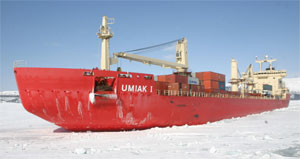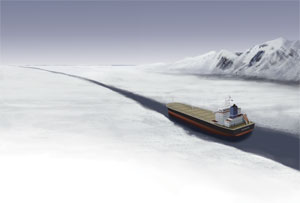The International Maritime Organization’s (IMO) safety committee has adopted the Polar Code, setting the stage for new safety and environmental standards for commercial ships visiting the Arctic.
The Maritime Safety Committee approved the Polar Code in November 2014. Additional discussion was scheduled for a February meeting, and its provisions are expected to go into effect in 2017 and 2018.
The Polar Code creates three tiers of qualifications for ships to operate in certain degrees of ice thickness. It enacts a “zero discharge” policy on oil-related waste in polar waters. Training in ice navigation and steering will be required. Ships must carry sufficient cold-weather lifesaving gear.
For the first time, each ship intending to transit a polar zone will need to apply for a Polar Ship Certificate and submit a customized Polar Water Operational Manual to its flag state. While vessels that frequently visit the Arctic or Antarctic usually have written safety management systems already, the new reporting may pose a challenge for some operators who don’t transit polar waters on a regular basis, said Capt. David “Duke” Snider, a former Canadian Coast Guard officer who is chief executive and principal consultant at Martech Polar Consulting Ltd.
“The polar operations manual is like your ISM procedures on steroids,” Snider said, referring to International Safety Management Code.
For each voyage, the ship’s officers will need to follow a procedure to assess the ice thickness, water temperature, weather conditions and other navigational considerations, such as how to minimize ice accretion.
“You have to identify the risks. (Currently) an experienced operator will do this, but not formally and not documented,” said Morten Mejlaender-Larsen, discipline leader for Arctic operation and technology at Det Norske Veritas. “Now you will have to document this and provide it to the flag state authorities. This is new for everyone.”
The Polar Ship Certificate will specify whether the vessel may sail in medium first-year ice with “old ice inclusions,” thin first-year ice, or merely open water with minimal ice. Each category will provide various requirements for design, construction, hull strengthening, stability, safety equipment and training.
“There are going to be some requirements that are going to be different for some operators who aren’t operating in the ice very often,” said Snider, who was a delegate for ice-related matters at IMO in his capacity as senior vice president at the Nautical Institute. “It could be something as simple as two 360-degree controllable searchlights so you can see and identify the ice at night.”
Among the largest and most experienced Arctic operators in North America is Montreal-based Fednav, which operates two Canadian-flagged ice-strengthened cargo ships and several others flying overseas flags. The company’s dry-bulk carriers, Arctic, Umiak I and Nunavik, are fitted with icebreaker bows. They serve northern customers including the nickel mines near Deception Bay and Voisey Bay, and the Red Dog mine in Alaska.
“The concern we have is being able to obtain the necessary certificates in a reasonable time,” said Tim Keane, Fednav’s manager of Arctic operations.
 |
|
Fednav’s icebreaking nickel carrier Umiak I arrives at the deepwater Edwards Cove port in Labrador. The newly approved Polar Code will codify new requirements for hull strengthening, safety equipment and training for commercial vessels transiting icy northern waters. |
|
Courtesy Fednav |
Another Canadian port that requires a polar transit, as defined by the code, is the grain terminal at Churchill, Manitoba, on Hudson Bay. Keane said some non-polar-specialty “market” ships sail to Churchill seasonally. These carriers may be the most inconvenienced by the Polar Code restrictions.
“The challenge is the vessels that are designed for worldwide operation but go into the polar waters in the summer,” Mejlaender-Larsen said. “The flag states will have to make up their minds as to how they will treat these vessels, and I would presume that these vessels would have to provide some documentation. It’s not the intention of the Polar Code to stop this kind of operation.”
Expanding commercial ports in Alaska are monitoring the Polar Code and its ramifications for certain vessels, sailing schedules and offshore oil exploration. Lucas Stotts, the harbormaster at the Port of Nome, said initially the impact will be minimal for existing operators, but that could change as bigger ships arrives.
“We are pushing Nome as a prime location for an Arctic deep-draft port. If Nome develops moorage facilities for larger deep-draft vessels, we would then have more dealings with these large international Arctic-going vessels,” Stotts said.
“As an Alaskan, I am happy to see the adoption of the Polar Code as I believe it will provide guidelines and standards for the larger international ships operating in Arctic waters that in the past have just passed by Nome silently in the distance without (us) knowing the standards being held on that vessel,” he said.
One incident that would have been different under Polar Code rules was the sinking of the cruise ship MS Explorer in Antarctica in November 2007, Snider said. In that case, the captain was inexperienced in Antarctic navigation and underestimated the ice thickness. The 91 passengers, all of whom survived, were evacuated using open lifeboats and drifted for five hours.
The Polar Code modifies the international conventions for Safety of Life at Sea and Prevention of Pollution from Ships. It will require a qualified ice navigator. Training requirements for basic and advanced levels will be determined later, with discussions at IMO’s Subcommittee on Human Element, Training and Watchkeeping in February.
Vessels will need ice-removal equipment such as electric or pneumatic devices, axes and wooden clubs. Fire safety gear must be approved for use in cold temperatures and suitable for operation by people wearing cumbersome cold-weather gear. Immersion suits and thermal protection will be required for all occupants of passenger ships.
“Discharge of oil or oily waste in the Arctic is a no-go,” Snider said. “You won’t get away with open lifeboats anymore. It has to be enclosed lifeboats or partially enclosed lifeboats, plain and simple.”
Keane said the industry and regulators need to get cracking on implementation.
“I have some concern about how the flag states and the owners and the operators are going to get together to see that this is done efficiently,” Keane said. “It’s incumbent upon all of us not to go to sleep now and wait until the code goes into effect. We need to have a dry run and see how the certificates will be issued if the code were to go into effect tomorrow.”

